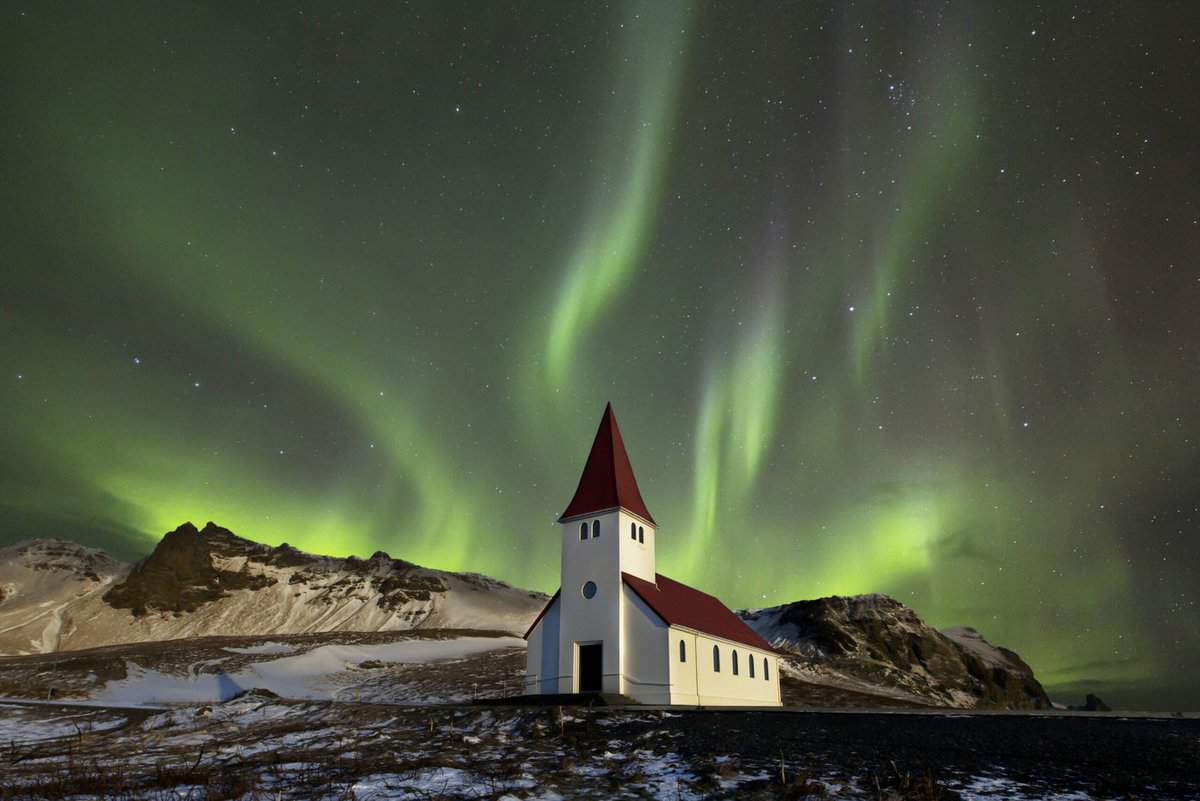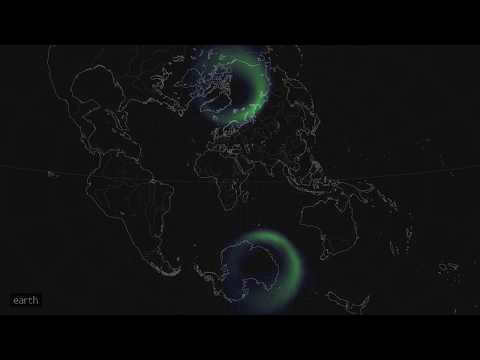
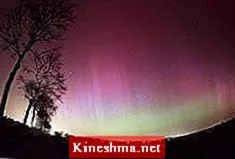
The Aurora is a natural occurrence of luminous light in the nighttime sky, predominantly in the polar regions of the Earth and other celestial bodies. This dazzling light display can appear in an array of vibrant hues – such as violet, indigo, emerald, golden, and crimson – and can manifest in various shapes, including stripes, arcs, and draperies.
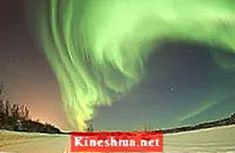
The phenomenon that some scientists refer to as the “aurora borealis” (or polar lights) has different names depending on the region. In the northern latitudes, it is commonly known as the Northern Lights or Northern Lights, while its southern counterpart is called the aurora australis or southern lights. The term Northern Lights is a combination of the name Aurora, who is the Roman goddess of dawn, and the Greek name for the north wind, Boreas. This natural light display is most commonly seen from September through October and March through April.
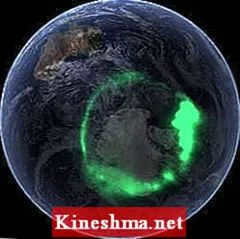
Auroral patterns and the power of magnets
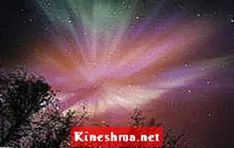
The aurora borealis usually appears in two forms: a diffuse glow or “curtains” that stretch from east to west. At times, “quiet arcs” can be seen, while other times show patterns constantly shifting, known as “active aurora borealis”. Each curtain is made up of multiple parallel rays, aligned with the magnetic field lines of force. This suggests that the Earth’s magnetic field shapes the aurora. In fact, satellites have shown that auroral electrons are guided by these magnetic field lines, spiraling around them as they travel towards Earth.
In 1741, Olof Hiorter (1696-1750) and Anders Celsius (1701-1744) initially detected additional indications of significant magnetic fluctuations that occurred whenever the aurora borealis was observed directly above. Subsequently, it was determined that the aurora borealis was linked to the presence of large electric currents flowing in the region from which it originated. Christian Birkeland (1867-1917) [1] eventually deduced that these currents move from east to west along the arc of the auroras, and they were later referred to as “auroral electric jets”.
Additional proof of a magnetic connection is provided by the data on observations of the aurorae. Elias Loomis (1811-1889) and later in more detail Hermann Fritz (1810-1882) [2] discovered that the aurora borealis primarily occurred in the “auroral zone,” which is a circular region with a radius of approximately 2500 kilometers (km) surrounding the magnetic pole (not the geographic pole) of the Earth. It was rarely observed near the actual pole. The immediate distribution of the aurorae is slightly different: the core of the aurorae is typically located around 3-5 degrees away from the magnetic pole during nighttime, and the arcs of the aurorae reach their farthest point from the equator around midnight. [3]

The interaction between solar wind and the magnetosphere
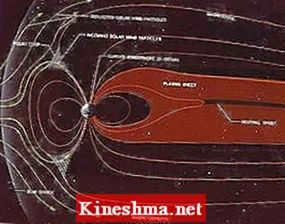
In order to comprehend the creation of the aurorae, it is crucial to grasp the interactions between the solar wind, the magnetic field of the Earth, and the interplanetary magnetic field (IMF). The region in outer space primarily shaped by these interactions is known as Earth’s magnetosphere. Within the magnetosphere, there exists a mixture of free ions and electrons that are primarily held together by magnetic and electric forces. The boundary that separates the magnetosphere from outer space is referred to as the magnetopause.
The Interplanetary Magnetic Field (IMF) is generated by the Sun and extends throughout the space between the planets of our solar system. It is closely connected to the sunspot activity and is influenced by the solar wind, which stretches its lines of force. Although the solar wind would naturally align these lines in the direction from the Sun to Earth, the rotation of the Sun causes a shift of approximately 45 degrees, resulting in the lines of force that intersect with the Earth starting near the western edge of the visible Sun. [4]
The magnetic field of the Earth dominates the region of space known as its magnetosphere, which acts as a barrier to the solar wind, redirecting it away. The magnetospheric obstacle measures approximately 90,000 kilometers wide when facing the Sun, while on the opposite side, a lengthy “magnetospheric tail” consisting of elongated lines of force extends over even greater distances.
Disturbances in the solar wind easily transfer energy and material to the magnetosphere, resulting in the energization of electrons and ions within it. These energized particles travel along the magnetic field lines towards the polar regions of the atmosphere, where they give rise to the phenomenon known as auroras.
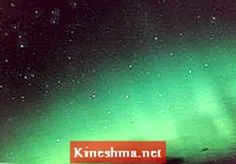
The phenomenon of the aurora borealis is frequently seen in the auroral ring zone that was mentioned earlier. On occasion, it can even be observed in areas with temperate latitudes when a powerful magnetic storm causes the auroras to expand their reach. These strong magnetic storms typically happen during the height of the eleven-year sunspot cycle or in the three years following it. Nevertheless, the likelihood of seeing the aurora borealis within the auroral zone largely relies on the inclination of the IMF lines, with a higher probability when the inclination is oriented southward.
Geomagnetic storms that result in auroras are more common during the months surrounding the equinoxes. The connection between geomagnetic storms and Earth’s seasons is not fully understood, unlike polar activity. However, it is known that during spring and fall, the Earth’s magnetic field and the magnetopause (MMP) are linked, as explained below. The MMP’s southward-facing lines create a pathway for solar wind energy to enter Earth’s inner magnetosphere.
Furthermore, the Sun has a 7-degree tilt in relation to the Earth’s orbital plane. This tilt causes the solar wind to blow faster from the Sun’s poles compared to its equator, resulting in varying speeds of particles hitting the Earth’s magnetosphere every six months. The fastest solar wind speeds, averaging around 50 km/s, occur on September 5 and March 5, coinciding with the Earth’s highest heliographic latitude.
However, the seasonal patterns of geomagnetic storms cannot be fully explained by the IMF lines or the solar wind alone. These factors only account for approximately one-third of the observed semiannual variations.
Significant Historical Auroral Occurrences
It is noteworthy for another reason as well, as it marked the first occasion where the occurrences of auroral activity and electricity were unequivocally linked. This discovery was made possible not only through scientific measurements conducted on magnetometers from that time period, but also due to the fact that a significant portion of the 125,000 miles of telegraph lines in operation at the time experienced substantial disruptions for several hours during a storm. However, it appears that certain telegraph lines were of sufficient length and alignment to allow for the induction of current in them (caused by the Earth’s highly fluctuating magnetosphere) and were actually utilized for communication.
The following exchange transpired between two operators of the American Telegraph Line connecting Boston and Portland on the evening of September 2, 1859, as recounted in the pages of the Boston Traveler:
Boston Operator (to Portland operator): “Could you please shut down the battery power source completely for a duration of fifteen minutes?”
Portland operator: “Certainly. It has been turned off now.”
Boston: “I have turned off my battery power source as well, and we are currently using the auroral current. How well are you able to receive my message?”
Portland: “Much better than when the batteries were on. The current fluctuates gradually.”
Boston: “The current can be very strong at times, and we find that we can work more effectively without the batteries. The northern lights seem to intermittently neutralize and strengthen our batteries, causing the current to become too strong for our relay magnets. Let’s continue working without the batteries until this issue is resolved.”
Portland: “That sounds like a good plan. Can I proceed with the matter at hand?”
Boston: “Yes, please go ahead.”
The discussion lasted for approximately two hours, without utilizing any battery and being solely powered by the electrical current induced by the aurora borealis. It was believed to be the first instance where multiple words were transmitted using this method. [5]
Auroral Mechanism
Based on the research conducted by Michael Faraday (1791-1867) in the early 1830s, it was established that when two electrical conductors are placed within a magnetic field and one conductor moves in relation to the other while a closed electrical circuit passes through both conductors, an electric current will be generated in the circuit. This process is utilized in electric generators (dynamos), but it can also be applied to plasma conductors (ionized gases).
Both the magnetosphere and the solar wind consist of plasmas, which have the ability to conduct electricity. The movement of these two entities should generate electric currents through a process called “dynamo action”. However, this process is hindered because plasma can easily travel along magnetic field lines, but not as easily perpendicular to them. Therefore, it is important to establish the timing of the magnetic relationship between the solar wind and magnetospheric force lines through a process known as magnetic reconnection. This is easiest when the magnetic field lines in the magnetosphere are tilted southward, as this aligns the lines of force near the Earth’s North Pole and South Pole. During these periods, active auroras are more likely to occur.
This electrical potential accelerates electrons to create the mesmerizing phenomenon known as the Northern Lights and is believed to be the primary cause of their formation. There are also other proposed mechanisms for the creation of the Northern Lights. One such mechanism involves Alfvén waves, which are a type of wave that involves a magnetic field and were first discovered by Hannes Alfvén (1908-1995). These waves have been observed both in laboratory settings and in outer space. [6]
Polar lights can be explained as the result of charged particles (such as electrons) in the magnetosphere colliding with atoms in the Earth’s upper atmosphere (above 80 km altitude). These charged particles typically have energies ranging from 1,000 to 15,000 electronvolts. When these particles collide with atmospheric gases, the atoms become energized. Eventually, the atoms release this energy in the form of light (known as fluorescence).
The light emitted by the aurora borealis is primarily composed of atomic oxygen emission, which creates a greenish glow (at a wavelength of 557.7 nm) and, at higher altitudes and lower energy levels, a dark red glow (at a wavelength of 630.0 nm). These colors result from forbidden transitions of oxygen atomic electrons, which persist for a significant amount of time and explain the gradual increase and decrease in brightness of auroral rays (lasting approximately 0.5-1 second). Additionally, other colors, such as blue and violet (emitted by atomic and molecular nitrogen, respectively), can also be observed. However, these colors change more rapidly and showcase the dynamic nature of the auroras.
Besides the emission of visible light, the aurorae also give off infrared (near-infrared and infrared) and ultraviolet (UV) radiation as well as X-rays. While the visible light of the polar lights is easily observable from Earth, the best view of UV and X-rays is obtained from space due to the Earth’s atmosphere absorbing and weakening these types of radiation.
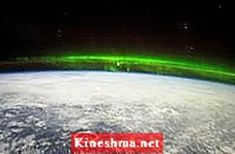
Moreover, the phenomenon known as the northern lights and the corresponding electric currents generate powerful radio waves at a frequency of approximately 150 kHz. This type of radiation is referred to as the “auroral kilometer radiation” (AKR) and was first observed in 1972. Due to the absorption of the ionosphere, AKR can only be detected from outer space.
Polar lights on other celestial bodies
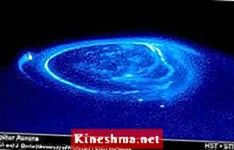
Both Jupiter and Saturn possess magnetic fields that are significantly stronger than that of Earth (Uranus, Neptune, and Mercury also possess magnetic fields), and both have extensive radiation belts. Hubble Space Telescope has observed polar auroras on both planets.
Similar to Earth, these auroras are caused by the solar wind. However, in addition, Jupiter’s moons (especially Io) are also potent sources of auroras. These auroras are generated by electric currents that run along the lines of force (known as “longitudinal currents”), which are produced by the dynamo due to the relative movement between the rotating planet and the moving moon. Io, which has active volcanism and an ionosphere, is an especially strong source, and its currents also generate radio emissions that have been investigated since 1955.
Recently, it has been discovered that the aurora borealis can also occur on Mars, despite previous beliefs that its weak magnetic field would prevent this phenomenon from happening. [8].
Early hypotheses
There have been several outdated theories proposed to explain auroral phenomena, including:
- The idea that auroral electrons originate from rays emitted by the Sun. This theory was put forth by Christian Birkeland around 1900. Birkeland’s experiments with electron beams and magnetized spheres, acting as miniature models of the Earth or “terrellas,” demonstrated that such electrons would be directed towards the polar regions. However, this model faced challenges such as the absence of auroras at the actual poles, the dispersion of these rays due to their negative charge, and the lack of supporting observational evidence in space.
- The phenomenon known as the aurora borealis is produced when particles from solar wind are directed by the Earth’s magnetic field towards the upper atmosphere. While this is true for the polar aurora cusp, the solar wind does not have direct access beyond this point. Additionally, the majority of the energy in the solar wind is carried by positive ions, with electrons only carrying about 0.5 electron-volts (eV). Although the energy of electrons can be increased to 50-100 eV in the cusp, it is still lower than the energy of the polar lights.
Auroral visuals
In today’s world, there has been a surge in the number of visuals capturing auroras, mainly due to the growing usage of digital cameras that possess high sensitivity. However, capturing auroral displays on film or digitally comes with its own set of challenges, especially when it comes to accurately reproducing the essence of the phenomenon. The reason behind this lies in the fact that auroras exhibit different spectral energies that undergo dynamic changes throughout the exposure, leading to somewhat unpredictable outcomes. Additionally, different layers of film emulsion respond in varying ways to lower light levels, making the choice of film crucial. Longer shutter speeds tend to blend rapidly changing energies, often obscuring the dynamic characteristics of the display. Furthermore, higher sensitivity settings can result in graininess issues.
David Malin was a pioneer in the field of astronomical photography, specifically in the use of multiple exposures and multiple filters. His innovative approach involved combining these images in the laboratory to create a more accurate representation of what the human eye would see. In scientific research, proxies such as ultraviolet light are frequently employed and can be recolored to resemble the appearance of the phenomenon being studied.
Prediction techniques are also utilized to determine the extent of the visual display, which is particularly valuable for those who hunt for auroras. One interesting aspect is that terrestrial objects often appear in photographs of the aurora borealis, adding an additional element to these images and making them more accessible to a wider audience. As a result, it is not uncommon for these photos to be featured on major websites and other popular platforms [9].
Aurora in mythology
In Norse mythology, there is an ancient account of the aurora borealis, which can be found in the Norse chronicles. The chronicles, known as Konungs Skuggsjá, were written in 1250 A.D. The author of the chronicles heard about the phenomenon from fellow Scandinavians who had returned from Greenland, and he provides three possible explanations for the northern lights: the idea that the ocean was surrounded by enormous fires, the theory that solar flares could reach across the globe and illuminate the night side, or the belief that glaciers could somehow store energy and eventually emit a fluorescent light.
In early Scandinavian folklore, the northern lights were referred to as the “herring flash”. It was believed that the lights were a reflection of large schools of herring swimming in the sky.
There is another account from Scandinavia that mentions “fires encircling the northern and southern boundaries of the earth.” This has been proposed as potential evidence of Norwegian explorations reaching as far as Antarctica, although it is not sufficient to draw a definitive conclusion.
In Finland, the phenomenon of the northern lights is referred to as revontulet, which translates to “fox fire.” According to folklore, foxes made of fire resided in Lapland, and the revontulet were the sparks that they emitted into the atmosphere with their tails.
In Estonian, the northern lights are called virmalized, which are believed to be spiritual entities from higher realms.
The Algonquin people held the belief that the shimmering lights in the sky were actually their ancestors joyfully dancing around a sacred fire.
In Inuit mythology, the aurora borealis is believed to be the spirits of the departed engaging in a game of soccer with human skulls high above the earth. The Inuit also used the northern lights as a way to guide their children home after nightfall, telling them that if they whistle in the presence of the lights, the spirits will descend and play soccer with their detached heads.
In Latvian folklore, the northern lights, particularly when they appear as a reddish hue during winter, are seen as a battle between the souls of fallen warriors, signifying impending disaster such as war or famine.
In Scotland, the aurora borealis were referred to as “merry dancers” or on the fir-whisker. There exist numerous ancient proverbs regarding them, such as the Scottish Gaelic saying, “When the merry dancers perform, it seems as though they were fighting.” The playful nature of the merry dancers occasionally resulted in a rather serious altercation, and the following morning when the children noticed traces of red lichen on the rocks, they whispered to one another that “the merry dancers spilled blood on each other last night.” The emergence of these lights in the sky was deemed a harbinger of impending inclement conditions.
Aurora, the ancient Roman goddess, has transformed into more than just a historical figure in works of art. She has become a powerful symbol of light, beauty, and youth. Do you find sunrises captivating? I’m certain that even if you are a fan of the early morning, you can hardly fathom how the transition from night to day was perceived by ancient civilizations.
In the minds of people who lived centuries ago, Aurora’s depiction as the dawn represented a triumph over darkness and malevolence. The myths surrounding Aurora paint a picture of extraordinary beauty. What did this goddess actually look like? Who were the fortunate individuals to become the lovers of the dawn deity? And why did her marital bliss only last for a brief period of time?
Aurora and her Greek “sister”
If you have an interest in the ancient history and myths of that era, it is likely that you are aware of the fact that the Romans borrowed several gods from Ancient Greece. It seems that the mighty conquerors were so captivated by the beauty and vividness of the ancient Greek tales that they chose to “replicate” them, recounting them in their own unique way.
Consequently, Aurora is essentially a precise replica of Eos, who was well-known in ancient Greece. Many of the myths surrounding Aurora are identical to the legends that recount the life of Eos.
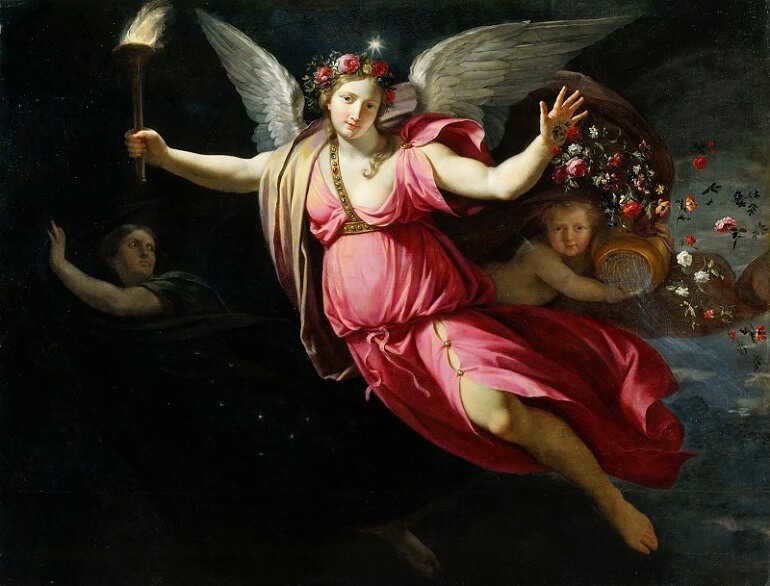
As I mentioned earlier, Aurora was the ruler of the sunrise. When darkness retreated from the sky, and the magnificent sun god was preparing to embark on his radiant chariot, Aurora would harness the horses that would lead the way to daylight. While she may not have been one of the supreme goddesses, her role was far from insignificant.
Not only was Aurora influential, but her family also held great power in the divine realm. Her siblings were Helios, the god of the sun, and Selene, who personified the moon. Aurora’s parents were believed to be the titan Teia and the titan Hyperion. Translating the name of the goddess literally, we derive a word similar to “pre-dawn breeze”.
Aurora, the Gorgeous Sunrise
What was the appearance of Aurora like? It is well known that numerous poets (including Alexander Pushkin) mentioned this goddess in their works as a symbol of youth and beauty. And could the guardian of the birth of a new day have a gloomy and dull appearance?
According to ancient writers, Aurora was often depicted as a winged goddess dressed in vibrant red and yellow garments, reminiscent of the fiery hues of the dawn. At times, a solar disc would shine above Aurora’s head, resembling a halo or a crown made of radiant beams of light.
Aurora would ride in her chariot or soar through the sky, holding a blazing torch in her hand, its flame illuminating the goddess’s path. Another attribute of the deity was a bowl of dew, which Aurora generously sprinkled over the herbs.
Aurora is not just a stunning sunrise, but also the celestial mother of all the stars that illuminate our night sky. The offspring of this exquisite goddess manifest as winds, each possessing their own unique characteristics: the mighty Boreas from the north, the gentle Zephyrus from the west, the moist Notus from the south, and the unpredictable Eurus from the east.
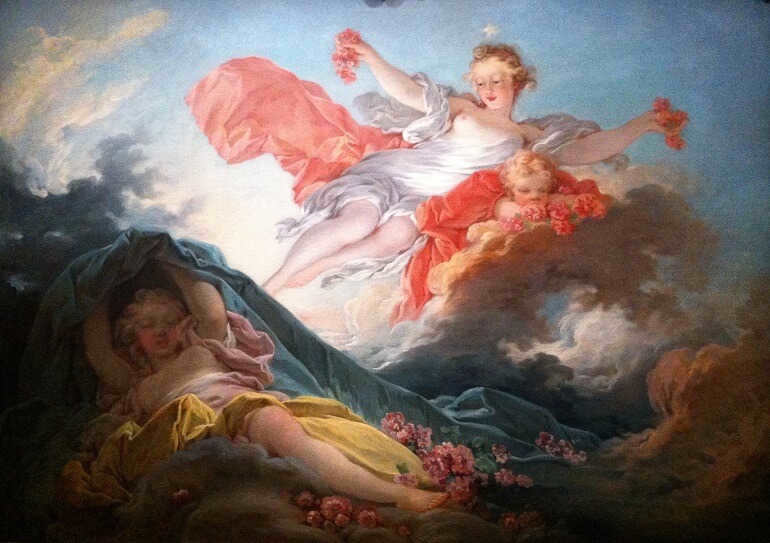
A Goddess of Passion and Frivolity
Venus herself, the goddess of love, would envy Aurora’s amorous nature. According to ancient legends, the sky would turn crimson whenever Aurora appeared, as she was renowned for her passionate temperament and disregard for her reputation.
One of Aurora’s most intense love affairs was with Tithon (Typhon), a mortal and the son of a Trojan king. The beautiful Aurora was so enthralled by his beauty that she even abducted him from his royal palace.
With her wings, she effortlessly carried Titon to Ethiopia, where he reigned and became Aurora’s partner. On the day of their wedding, Aurora made a plea to Jupiter, asking him to grant immortality to Titon so that they could forever bask in the joy of their love. The Thunderer granted the goddess’ request, but Aurora made a crucial oversight. Instead of asking for eternal youth for her spouse, she only asked for eternal life.
Unfortunately, after many years, the immortal Titon transformed into an old man, no longer fitting beside the perpetually youthful and blossoming Aurora. Realizing the vast chasm of time that separated them, Aurora beseeched the supreme god to show mercy to her beloved. Titon was then transformed into a cricket, who now sings a mournful song about his fate every evening and morning dawn.
The beauty of love and the pain of grief
With another mortal named Kefal, things took a different turn. Initially, he rejected the goddess, which only fueled her passion to conquer him. Aurora was so captivated by this handsome man that she forgot about everything else, neglecting her daily responsibilities.
The world could have descended into chaos, but the clever Cupid came to the rescue and struck Kephalus with a love arrow. This brought happiness to Aurora, and she didn’t repeat her past mistake. She took her husband to heaven, granting him not only immortality but eternal youth as well.
Unfortunately, even Aurora experienced the pain of loss. Her son, Memnon, who was only half-god, perished at the hands of Achilles during the Trojan War. The inconsolable goddess wept as her son’s body was cremated on a funeral pyre near Troy.
Legend has it that at that very instant, the smoke transformed into dark ravens, who return to this spot each year on the exact same day to pay tribute to Memnon’s memory.
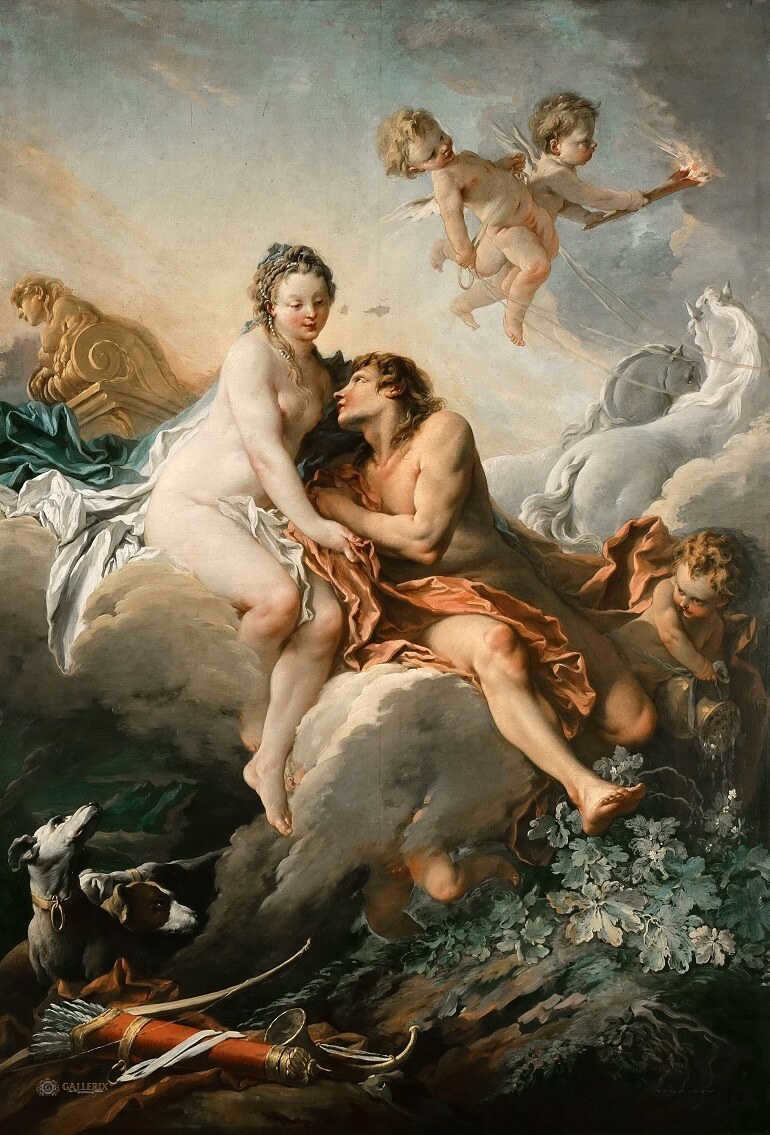

This portrait of Aurora, the Roman goddess of dawn, is both intriguing and intricate. While she may appear frivolous and carefree, it is important to remember that she brings light and a new day into the world, adorning leaves and grass with precious dew. The beauty of dawn is Aurora’s most valuable gift to all of us.
Aurora, a feminine name derived from ancient Roman mythology, is synonymous with the word “dawn” but has fallen out of common usage.
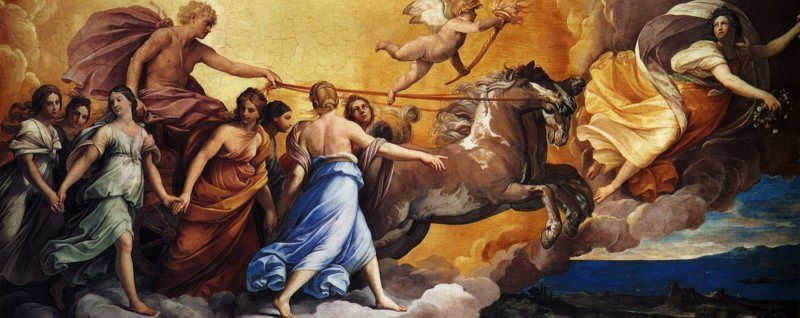
Etymology of the Term
The term “aurora” in Russian is derived from the Latin word “aurora,” which means “dawn” or “morning dawn.”
In Roman mythology, Aurora was the sister of the sun god Helios and the moon goddess Selene. Her name is derived from the Latin words “aura,” meaning “predawn breeze,” and “aurum,” meaning “golden.” The goddess is typically depicted as winged, with a halo of sun rays, and sometimes riding a chariot with vessels filled with dew.
Fresco by Guido Reni, 1614. Photo: Wikimedia
According to M.V. Lomonosov’s 1753 project titled “The Illumination and Fireworks Plan for the Grand Celebration of Her Imperial Majesty’s Birth on December 18, 1753,” it was proposed to have a unique display. This display would feature Aurora, riding in a chariot pulled by white fire-breathing horses. She would hold a torch in one hand and have the morning star on her forehead. In her other hand, she would hold a banner with zephyrs and the first letter of Her Imperial Majesty’s name, “E”.
Aurora and her husband, the titan Astrea, were believed to be the source of all the stars in the sky and all the winds.
Pushkin’s Aurora
Open your eyes that were closed with nakedness.
Towards the northern Aurora,
(A.S. Pushkin, “Winter Morning,” 1829)
Even though Pushkin used a capital letter for the word “aurora”, it is a common noun: the name of the goddess is associated with the morning dawn itself. Thanks to Russian poets, this word is still used as a synonym for dawn.
Photo: Depositphotos
Aurora is also the name of the main character in Tchaikovsky’s ballet based on the libretto by I. Vsevolozhsky and Marius Petipa’s The Sleeping Beauty.
Currently, the pseudonym Aurora is used by Russian TV host Irina Yuryevna Yudina, who has presented shows on Muz-TV, Channel One, and TNT.
What is the desire of the cruiser Aurora?
Aurora is the title given to one of the symbolic ships during the October Revolution of 1917. It is a famous cruiser that belonged to the “Diana” type of the Baltic Fleet. The ship played a significant role in the Battle of Tsushima during the Russo-Japanese War of 1904-1905. A blank shot fired from the Aurora served as the signal for the militants to initiate the storming of the Winter Palace in St. Petersburg.
The song “Aurora” by Vladimir Shainsky, with lyrics written by Mikhail Matusovsky, later became one of the unofficial anthems of Leningrad. In light of the revolutionary events, the name Aurora also gained popularity as a female name.
The photograph depicts the cruiser Aurora in the Baltic Sea after 1909. Source: Wikimedia
The cruiser was given the name Aurora to honor the sailing frigate of the same name, which gained fame during the Crimean War from 1853 to 1856. Legend has it that Nicholas I personally named the frigate after Aurora Karlovna Demidova-Karamzina, one of the most beautiful women in St. Petersburg and a maid of honor to his wife Alexandra Fyodorovna. Alternatively, some sources suggest that the frigate was named after an ancient Roman goddess.
Aurora, in ancient Roman mythology, is the goddess of the morning dawn and also a female name. It is also considered an outdated synonym for the word “dawn”.
The term aurora was borrowed into Russian from Latin – aurora, which means “dawn, morning dawn”.
In Roman mythology, the goddess Aurora was the sister of the sun god Helios and the moon goddess Selene. Her name is derived from the Latin words aura, meaning “predawn breeze”, and aurum, meaning “golden”. Typically, the goddess is depicted as winged, with a halo of sunbeams, sometimes riding in a chariot and carrying vessels filled with dew.
Fresco painted by Guido Reni in 1614. Photo: Wikimedia
"For a single wick design, it is necessary to intentionally raise it from the ground and elevate it. This design will depict Aurora riding in a chariot pulled by white fire-breathing horses. Aurora will hold a torch in one hand and wear a morning star on her forehead. In her other hand, she will hold a banner with zephyrs that form the first letter of Her Imperial Majesty’s name: "E". M. V. Lomonosov described this design in his work titled "The project of illumination and fireworks for the solemn celebration of the birth of Her Imperial Majesty on December 18, 1753" (1753).
All the stars in the sky and all the winds are said to originate from Aurora and her husband, the titan Astrea.
Pushkin’s Aurora
Open your eyes that were once closed.
Heading towards the majestic Aurora in the north,
(A.S. Pushkin, “Winter Morning,” 1829)
Even though Pushkin gave the word “Aurora” a capital letter, it is a common noun: the name of the goddess is intertwined with the early morning light itself. Thanks to Russian poets, this term is still used as a synonym for daybreak.
Aurora is also the name of the main character in Tchaikovsky’s ballet, “The Sleeping Beauty,” which is based on the libretto by I. Vsevolozhsky and Marius Petipa.
Presently, Russian TV presenter Irina Yurievna Yudina goes by the pseudonym Aurora and has worked on various programs for Muz-TV, Channel One, and TNT.
What is the vision of the cruiser Aurora?
The cruiser Aurora, known as one of the symbols of the October Revolution of 1917, is a legendary ship of the “Diana” type in the Baltic Fleet. During the Russo-Japanese War of 1904-1905, it played a role in the Battle of Tsushima. The commencement of the assault on the Winter Palace in St. Petersburg was signaled by a blank shot fired from the Aurora.
The song “Aurora” by Vladimir Shainsky, with lyrics by Mikhail Matusovsky, later became an unofficial anthem of Leningrad. Due to the revolutionary events, the name Aurora also gained popularity as a female name.
Photograph of the cruiser Aurora in the Baltic Sea after 1909. Source: Wikimedia

